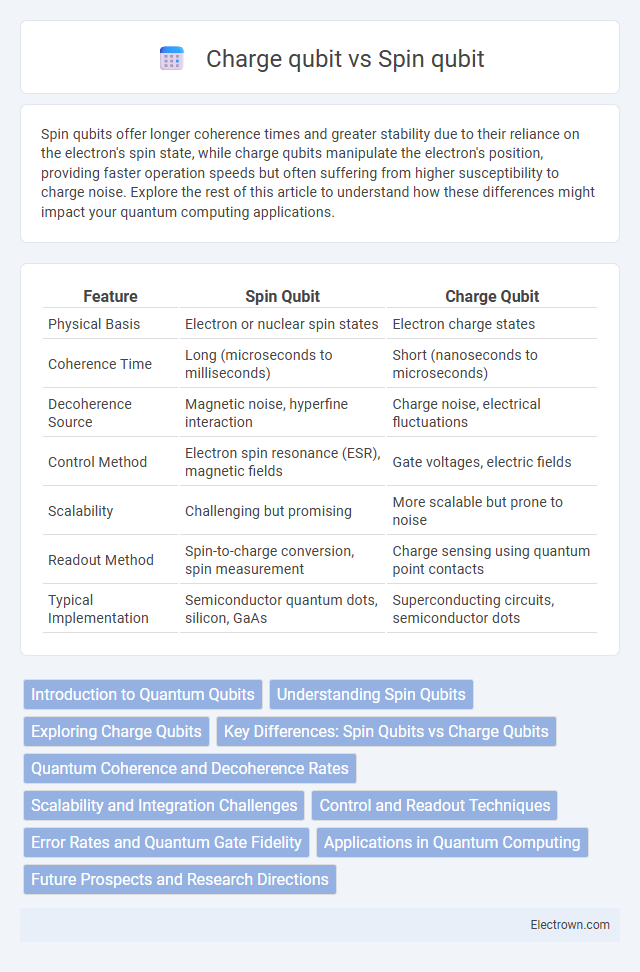Spin qubits offer longer coherence times and greater stability due to their reliance on the electron's spin state, while charge qubits manipulate the electron's position, providing faster operation speeds but often suffering from higher susceptibility to charge noise. Explore the rest of this article to understand how these differences might impact your quantum computing applications.
Table of Comparison
| Feature | Spin Qubit | Charge Qubit |
|---|---|---|
| Physical Basis | Electron or nuclear spin states | Electron charge states |
| Coherence Time | Long (microseconds to milliseconds) | Short (nanoseconds to microseconds) |
| Decoherence Source | Magnetic noise, hyperfine interaction | Charge noise, electrical fluctuations |
| Control Method | Electron spin resonance (ESR), magnetic fields | Gate voltages, electric fields |
| Scalability | Challenging but promising | More scalable but prone to noise |
| Readout Method | Spin-to-charge conversion, spin measurement | Charge sensing using quantum point contacts |
| Typical Implementation | Semiconductor quantum dots, silicon, GaAs | Superconducting circuits, semiconductor dots |
Introduction to Quantum Qubits
Spin qubits leverage the intrinsic angular momentum of electrons to represent quantum information with high coherence times, making them promising candidates for scalable quantum computing. Charge qubits exploit the electron's position within quantum dots, enabling fast manipulation but often suffering from shorter coherence times due to environmental charge noise. Understanding the fundamental differences in coherence properties and control mechanisms between spin qubits and charge qubits is critical for advancing quantum information processing technologies.
Understanding Spin Qubits
Spin qubits leverage the intrinsic angular momentum of electrons, offering longer coherence times compared to charge qubits, which rely on electron position and are more susceptible to environmental noise. Understanding spin qubits involves recognizing their potential for scalable quantum computing due to lower error rates and compatibility with existing semiconductor technology. Your choice of qubit type impacts quantum processor stability, where spin qubits typically provide enhanced reliability for complex quantum algorithms.
Exploring Charge Qubits
Charge qubits operate by manipulating the position of an electron within a double quantum dot, offering fast operation speeds due to strong coupling with electric fields. Despite their susceptibility to charge noise and decoherence, advancements in material quality and error correction techniques have improved their coherence times significantly. Charge qubits remain a promising platform for scalable quantum computing, particularly in applications requiring rapid gate operations and integration with existing semiconductor technologies.
Key Differences: Spin Qubits vs Charge Qubits
Spin qubits utilize the intrinsic angular momentum of electrons, offering longer coherence times due to reduced sensitivity to electrical noise, while charge qubits rely on the position of electrons, making them faster but more prone to decoherence. Your choice between spin and charge qubits impacts quantum computing stability and speed, with spin qubits favored for error resilience and charge qubits for rapid gate operations. The different physical implementations of these qubits define their trade-offs in scalability and control precision.
Quantum Coherence and Decoherence Rates
Spin qubits exhibit longer quantum coherence times compared to charge qubits, primarily due to their weaker coupling to electrical noise, which results in significantly lower decoherence rates. Charge qubits, being highly sensitive to fluctuations in the electric field, suffer from rapid decoherence, limiting their performance in quantum computing applications. To enhance Your quantum device's stability, leveraging spin qubits offers a strategic advantage through improved coherence and reduced error rates.
Scalability and Integration Challenges
Spin qubits offer better scalability due to their longer coherence times and smaller physical footprint, enabling dense qubit arrays essential for large-scale quantum processors. Charge qubits face integration challenges from their susceptibility to electrical noise and shorter coherence times, which complicate maintaining qubit fidelity as the system scales. Advances in materials and fabrication techniques are crucial to overcoming these challenges and achieving practical quantum computing architectures.
Control and Readout Techniques
Spin qubits are controlled using magnetic resonance techniques, such as electron spin resonance (ESR) or electric dipole spin resonance (EDSR), enabling precise manipulation of electron spin states with microwave pulses. Charge qubits rely on voltage pulses applied to gate electrodes for control, exploiting the position of an electron in quantum dots or superconducting islands. Readout for spin qubits often involves spin-to-charge conversion detected by charge sensors like quantum point contacts, while charge qubits are directly measured through charge-sensitive electrometers or quantum capacitance, offering faster but more noise-sensitive readout.
Error Rates and Quantum Gate Fidelity
Spin qubits exhibit lower error rates and higher quantum gate fidelity compared to charge qubits due to their reduced susceptibility to charge noise and decoherence. Charge qubits, while faster in operation, suffer from increased error rates caused by environmental charge fluctuations, impacting overall quantum gate precision. Optimizing your quantum device with spin qubits can enhance stability and improve gate fidelity essential for scalable quantum computing.
Applications in Quantum Computing
Spin qubits offer longer coherence times and higher fidelity for quantum error correction, making them ideal for scalable quantum processors in quantum computing. Charge qubits enable faster gate operations due to strong electric dipole coupling, which facilitates rapid quantum logic gates essential for real-time quantum algorithms. The integration of spin and charge qubits leverages both coherence and speed, enhancing the performance of hybrid quantum computing architectures in complex problem solving and quantum simulation.
Future Prospects and Research Directions
Spin qubits offer promising scalability and longer coherence times essential for fault-tolerant quantum computing, making them a primary focus for future research in quantum processors. Charge qubits provide faster gate operations but face challenges with decoherence, prompting ongoing studies to enhance their stability through improved materials and error correction techniques. Your exploration of quantum technologies should consider the integration of hybrid approaches, combining spin and charge qubit advantages to optimize performance and robustness.
spin qubit vs charge qubit Infographic

 electrown.com
electrown.com